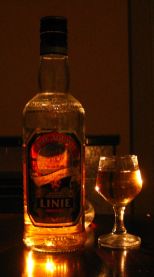Akvavit
Akvavit or aquavit is a distilled spirit that is principally produced in Scandinavia, where it has been produced since the 15th century. Akvavit is derived from the Latin aqua vitae, meaning "water of life". The spirit is made from grain and potatoes, and it is flavored with a variety of herbs and spices, primarily caraway or dill. It is traditionally consumed during festive gatherings such as Christmas dinners and weddings, often as part of a toast or skål in Scandinavian culture.
Production[edit | edit source]
The production of akvavit begins with the distillation of grain or potatoes, creating a clear, high-proof spirit. This spirit is then flavored with herbs and spices, with caraway or dill being the most common primary flavor. Other botanicals used may include anise, fennel, lemon or orange peel, cardamom, cumin, and coriander. The specific recipe and the combination of herbs and spices vary by brand and region, contributing to the distinct character of each akvavit. After flavoring, the spirit may be aged in oak casks, which can impart additional complexity and smoothness to the final product. The aging process varies, with some akvavits being aged for several years, while others are bottled immediately after flavoring.
Consumption[edit | edit source]
Akvavit is typically served chilled and in a small shot glass, often accompanied by traditional Scandinavian dishes, particularly those involving fish and pickled herring. It is also a key ingredient in some cocktails and culinary recipes. In Scandinavian tradition, akvavit is often consumed during festive occasions, such as Christmas and midsummer feasts, where it is enjoyed as part of a skål, a traditional toast.
Varieties[edit | edit source]
There are many varieties of akvavit, each with its unique flavor profile influenced by the type and amount of spices and herbs used, as well as the method and duration of aging. Some notable varieties include:
- Danish Akvavit: Often characterized by a pronounced dill or coriander flavor and typically less sweet than its counterparts.
- Swedish Akvavit: Known for its complex spice blend, including caraway, anise, and fennel, and sometimes aged in oak barrels.
- Norwegian Akvavit: Distinct for its aging process, often in oak barrels that have previously held sherry, contributing to a richer flavor profile.
Cultural Significance[edit | edit source]
Akvavit holds a significant place in Scandinavian culture, symbolizing hospitality and good cheer. Its consumption during festive occasions is a deeply ingrained tradition, reflecting the spirit's historical role as a celebratory drink. The ritual of the skål, involving toasting with akvavit, is a key aspect of this tradition, fostering a sense of community and belonging.
Regulations[edit | edit source]
The production and labeling of akvavit are subject to regulations that vary by country. In the European Union, akvavit must be produced in Scandinavia and must contain caraway and/or dill to be legally sold as akvavit. These regulations help to protect the traditional methods and cultural heritage associated with the spirit.
Search WikiMD
Ad.Tired of being Overweight? Try W8MD's physician weight loss program.
Semaglutide (Ozempic / Wegovy and Tirzepatide (Mounjaro / Zepbound) available.
Advertise on WikiMD
|
WikiMD's Wellness Encyclopedia |
| Let Food Be Thy Medicine Medicine Thy Food - Hippocrates |
Translate this page: - East Asian
中文,
日本,
한국어,
South Asian
हिन्दी,
தமிழ்,
తెలుగు,
Urdu,
ಕನ್ನಡ,
Southeast Asian
Indonesian,
Vietnamese,
Thai,
မြန်မာဘာသာ,
বাংলা
European
español,
Deutsch,
français,
Greek,
português do Brasil,
polski,
română,
русский,
Nederlands,
norsk,
svenska,
suomi,
Italian
Middle Eastern & African
عربى,
Turkish,
Persian,
Hebrew,
Afrikaans,
isiZulu,
Kiswahili,
Other
Bulgarian,
Hungarian,
Czech,
Swedish,
മലയാളം,
मराठी,
ਪੰਜਾਬੀ,
ગુજરાતી,
Portuguese,
Ukrainian
Medical Disclaimer: WikiMD is not a substitute for professional medical advice. The information on WikiMD is provided as an information resource only, may be incorrect, outdated or misleading, and is not to be used or relied on for any diagnostic or treatment purposes. Please consult your health care provider before making any healthcare decisions or for guidance about a specific medical condition. WikiMD expressly disclaims responsibility, and shall have no liability, for any damages, loss, injury, or liability whatsoever suffered as a result of your reliance on the information contained in this site. By visiting this site you agree to the foregoing terms and conditions, which may from time to time be changed or supplemented by WikiMD. If you do not agree to the foregoing terms and conditions, you should not enter or use this site. See full disclaimer.
Credits:Most images are courtesy of Wikimedia commons, and templates, categories Wikipedia, licensed under CC BY SA or similar.
Contributors: Prab R. Tumpati, MD


